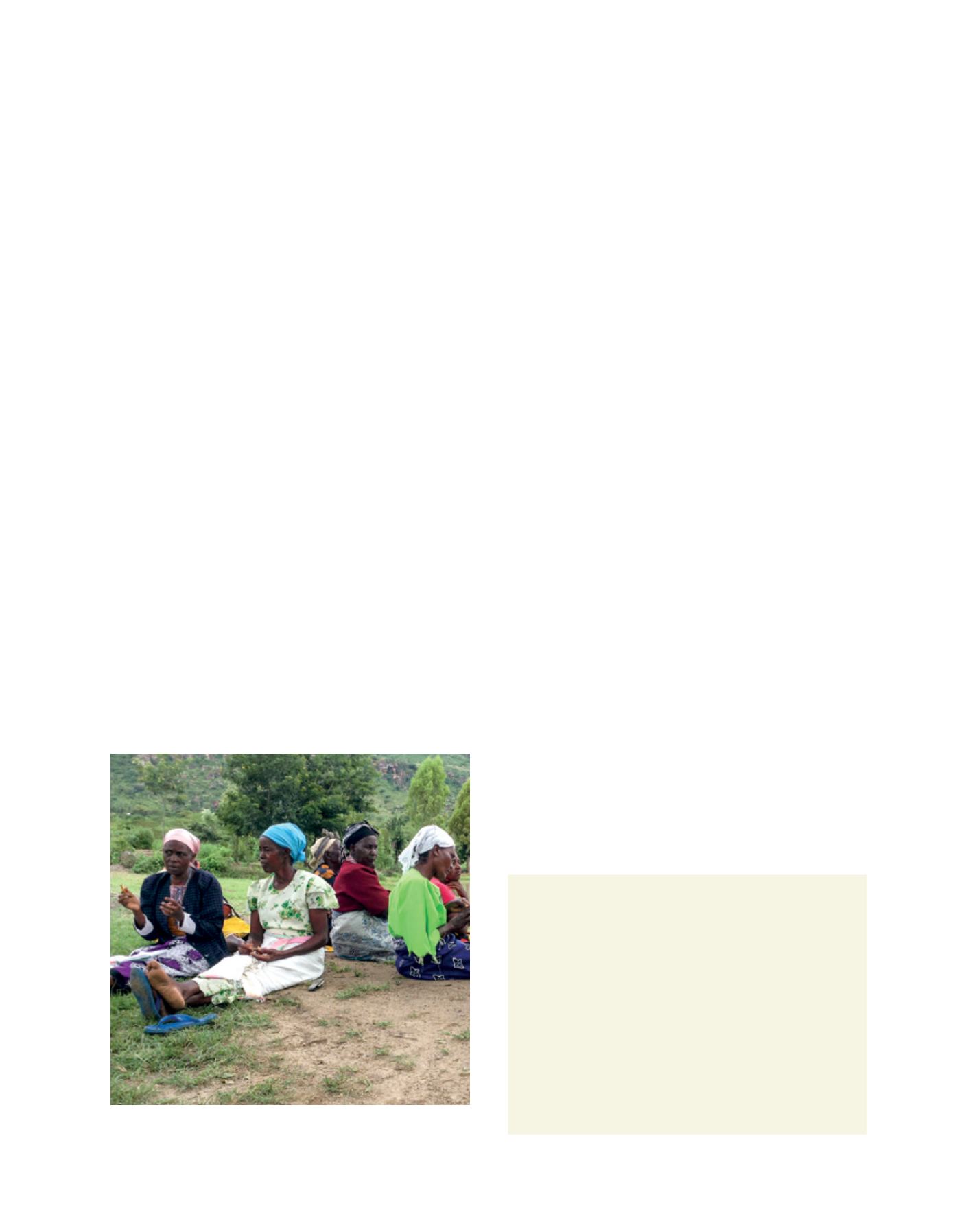

[
] 208
Lessons learned
1. Social protection programmes targeting poor and vulnerable
community members can work if targeting is rigorous and
involves the direct participation of community members.
2. To succeed with inputs subsidy programmes, the beneficiaries
should be willing to learn and comply with the recommended
agronomic practices including the correct use of inputs in raising
productivity per unit of land.
3. There is value in applying technical knowledge gained through
trainings and graduating the beneficiary to become a local trainer
for the community members.
4. Most small-scale farmers are trapped in a poverty cycle because
there are no sufficient social protection programmes. Several
smallholder, poor farmers in Molo are yet to get NAAIAP assistance
because of inadequate funds available for project expansion.
the primary objective of NAAIAP is to improve input access
and affordability of the key agricultural inputs needed by
millions of resource-poor, smallholder farmers. In so doing,
the project aims at helping poor households to kick-start their
asset-deprived farming systems and break their poverty cycles
through the adoption of intensive, business-oriented farming
systems. Overall, NAAIAP is implemented within underdevel-
oped rural settings that are dominated by poor and vulnerable
communities. According to the programme national coordi-
nator Rose Mwangi, what makes the NAAIAP concept very
special is its fabled beneficiary-selection activities. The start-
ing point is the criteria for selecting the implementation
site. The stringent measures include a requirement that the
place must be inhabited by a poor farming community with a
poverty index above 30 per cent; no history of government-
support programmes over the last decade; inaccessibility of
basic production assets and other essential rural infrastruc-
ture; and very low agricultural productivity of less than a
quarter of the national average.
As a pro-poor targeted programme, the criterion for
selecting the beneficiaries is equally rigorous. First, the target
beneficiary must be a subsistence farmer who is unable to
procure required farm inputs on their own. Secondly, the
farmer must have at least half an acre of land available for
maize production, which is the commodity used as a cruci-
ble for changing the farmers’ livelihoods. During selection,
preference is given to households headed by women or chil-
dren households. The other factors for a household’s selection
include demonstrated evidence of vulnerability, the house-
hold head being a person with a disability or infected by the
HIV/AIDs virus, and the household’s willingness to change
through the adoption of intensive farming based on a sustain-
able business model. To ensure the utmost transparency, the
ultimate beneficiary must be brazenly vetted and approved
by the community leaders in an open forum (known locally
as a Baraza) with members of the community as witnesses.
To NAAIAP beneficiaries, the word ‘vulnerable’ has a second
meaning: undo vulnerability.
Mrs Kosgei became a NAAIAP beneficiary through a quirk
of fate. Initially, she had applied to be a NAAIAP beneficiary
but fell short of the project’s meticulous criteria. But her
house happened to be the home of Johnston Yegon, who had
become disabled through a grisly road accident and therefore
could not provide for his young family of a wife and two chil-
dren. Mr Yegon, a distant relative of Mrs Kosgei, is the one
who was initially selected by the community leaders to be
the NAAIAP beneficiary. And so when Mr Yegon was called
upon to receive his farm inputs voucher by the NAAIAP team
during the project launch, it was Mrs Kosgei who turned up
to receive the voucher on his behalf. The knowledge that Mrs
Kosgei’s household accommodated Mr Yegon facilitated the
crafting of a secondary condition: Mrs Kosgei’s household
would use the subsidized inputs in line with the NAAIAP
approach and pass over part of the gains to the Yegons. The
only danger this arrangement carried was that of a mixed reac-
tion among local leaders who defined the last vetting lines. But
after the leaders gave a no-objection nod to the arrangement,
Mrs Kosgei never looked back.
When Mrs Kosgei received the farm inputs package, she
vowed not to join the bandwagon of those willing to cross
the river without getting wet. Recalling her household’s situ-
ation before she became a NAAIAP beneficiary, the harvest
of a meagre seven bags of maize which, as the best she ever
received from planting 1.5 acres of land, was far below the
area’s potential yield of 25 bags per acre. “Due to lack of
resources and knowledge, I used to plant maize seeds recycled
from the store and did not use any fertilizer,” said the farmer
on being questioned about low yields.
In the 2012 long rains planting season, Mrs Kosgei
received her Kilimo Plus (Inputs Grant) starter kit compris-
ing a 50 kilogram bag of Basal fertilizer (DAP), 50 kilograms
of topdressing fertilizer (CAN) and a 10 kilogram bag of
certified maize seed (H614) worth a total of KSh8,000
(about US$9). From her Merry-go-round social group, she
borrowed a further Ksh5,000 to plough and plant her 1 acre
farm using the NAAIAP inputs. After planting, Mrs Kosgei
joined other NAAIAP beneficiaries to undertake training on
Beneficiaries of the programme are able to apply the knowledge they gain
and become local trainers for their community
Image: NAAIAP
D
eep
R
oots
















